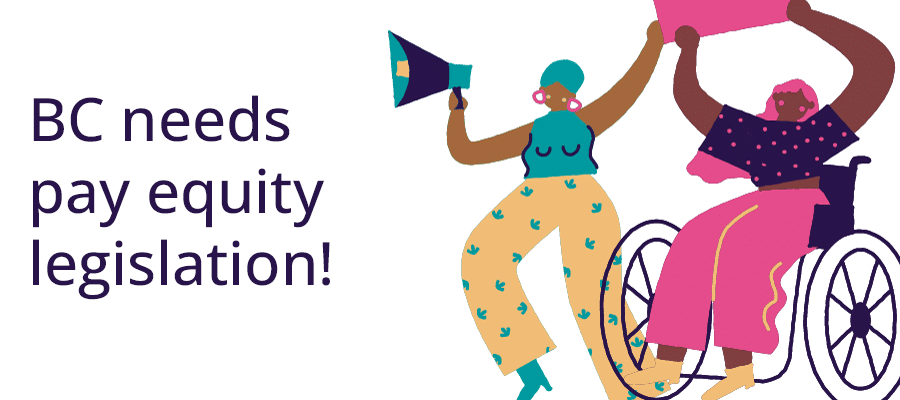Tracking the gender gap in Canada’s big cities: How’s BC doing?

A new report released today uncovers important gaps in the experiences of men and women across Canada. The CCPA’s annual study of the Best and Worst Places to be a Woman in Canada by Kate McInturff ranks the country’s largest cities according to the gaps between men’s and women’s access to economic security, education, health, positions of leadership and personal safety.
In 2017, Victoria leads the country, ranking as the Canadian city with the smallest gender gap for the third year in a row. BC’s three other large metropolitan areas rank in the top half with Metro Vancouver in fifth place, Kelowna in 14th and Abbotsford-Mission in 15th.
As with any index, the average scores obscure significant differences in the experiences of Indigenous, immigrant and racialized women, as well as women with disabilities and queer and transgender women, from that of the average Canadian woman. However, the report provides a useful snapshot of the gender gaps in Canada’s urban areas and helps us track progress on closing them.
BC’s large cities do particularly well when it comes to representation in municipal government compared to the rest of the country. Abbotsford-Mission comes close to parity with women elected to 48% of the municipal positions there. Victoria is a close second, with women filling 45% of municipal elected positions when all Greater Victoria municipalities are considered. Metro Vancouver follows with 40%.
Victoria stands out from the rest of the country in having more women in leadership and a smaller gender gap in economic security. The gender gap in full-time employment is smaller than the rest of the country, though the gap in annual earnings between women and men is only slightly smaller than the Canadian average. Better employment opportunities for women mean less poverty; Victoria mirrors this as one of the few cities in Canada where women are less likely to live in poverty than men.
Why is Victoria doing well? Other research has found that public sector workplaces have made more progress in closing the gender pay gap than private sector employers. And the same is true for wage gaps for Indigenous and racialized Canadians, which tend to be smaller in public sector workplaces. This is likely why cities with a large public sector employer (like Victoria and Gatineau) tend to see a much smaller gender gap in economic security.
It is too early to pat ourselves on the back. When it comes to the gender gap in economic participation and wages, BC is home to both the lowest gender gap in economic security (Victoria) and the highest (Abbotsford-Mission) in Canada.
It is too early to pat ourselves on the back. When it comes to the gender gap in economic participation and wages, BC is home to both the lowest gender gap in economic security (Victoria) and the highest (Abbotsford-Mission) in Canada.
In addition, BC cities do poorly when it comes to women’s representation in senior management positions, with the notable exception of Victoria. Women staff 45% of management positions in Victoria (the highest in the country), but only occupy 30–34% of management positions in BC’s other big cities. Kelowna ranks fourth from the bottom, with a large gender gap in employment and earnings, while Vancouver is in the middle of the pack at number 16. This is a major area upon which BC cities need to focus.
More generally, Kate McInturff’s report highlights areas where Canada has successfully reduced the gender gap as well as areas where more work is necessary. For example, we find that women and men generally have equitable access to education and health services. In fact, women’s education levels are greater than men’s except for in the trades. Having more education, however, has not eliminated the gender gap in economic security or in access to leadership positions in government or business.
Canadian cities share another challenge: rates of sexual assault and domestic violence remain persistently high across the country. Little has changed over the past 20 years and as the #MeToo campaign is showing us sexual assault and harassment is pervasive in Canada. We can no longer dismiss this abuse as unfortunate cases of a few bad apples (or Harvey Weinsteins or Jian Ghomeshis) and need to treat it as the systemic problem it is.
BC cities may have average or lower-than-average reported rates of domestic violence and sexual assault, but the bar is low and police-reported statistics are well known to be incomplete. BC police departments appear to be less likely to dismiss reports of sexual assault than the average Canadian police department. However, serious problems remain across the country as Robyn Doolittle’s groundbreaking investigative research for the Globe and Main found.
BC cities may have average or lower-than-average reported rates of domestic violence and sexual assault, but the bar is low.
It’s a little known fact that Canada slipped to 35th place in the World Economic Forum’s 2016 Global Gender Gap Report so we are far from the best place to be a woman in the world. Closing the gender gap is a big job and the responsibility must shared—employers, government and communities all have important roles to play.
In BC and Canada-wide, women are more likely to work in low-wage jobs and are more likely to live in poverty than men, so progress in poverty reduction and efforts to bring wages closer to a living wage would also reduce the gender gap in economic security.
Public policies that make it easier for women to combine paid work and family responsibilities—by having affordable quality child care, home care and elder care programs, generous parental leave provisions, paid sick time and longer paid vacations—will greatly reduce the gender gaps in economic security, access to leadership and even personal security (as women won’t be as financially dependent on men). The CCPA’s Kate McInturff outlines five key priorities for the federal government here.
Employers must closely examine their payrolls to see if they pay women and men differently for the same work. Recently, Wilfrid Laurier University found a gender gap in their professors’ wages and gave all female faculty members a salary bump.
A study by the Conference Board of Canada found that young women are less likely to be promoted than their male counterparts so it’s equally important for employers to consider if internal promotion pathways contribute to an opportunity gap between men and women. These exercises should not be considered one-offs. Experience from US companies doing this work shows that constant monitoring is necessary or inequality will keep creeping back in.
The good news is that we’re talking more about this important issue. There are many great local initiatives working to close the gender gap that we can learn from. For example, the Central Okanagan Women’s Resource and Education Foundation provides research and education on how violence, mental health, poverty and child care options impact women’s ability to fully participate in society. In Vancouver, Women Transforming Cities is working to increase women’s participation in local governments and a number of cities have active campaigns aimed at electing more women to city council, including Ask Her in Calgary, le Groupe Femmes, Politique et Démocratie in Quebec and Women Win Toronto to name just a few.
—
More about the methodology: The CCPA’s Senior Researcher Kate McInturff developed the ranking, which builds on global indexes of gender equality used by the World Economic Forum and the United Nations. It’s augmented to include measures of violence against women, which none of the international indices has been able to include so far (due to data limitations). The Canadian data exists but local-level statistics are poor, limited to police reports, which misses the vast majority of incidents that go unreported. It is well known that population-level surveys provide more reliable information about the true prevalence of violence against women, however Statistics Canada’s violent crime survey is conducted only every five years and sample sizes are too small to get at municipal level data outside of Ontario and Quebec. This report also calls for better data collection on women’s experiences of domestic violence, sexual assault and harassment in Canada.
Topics: Women

